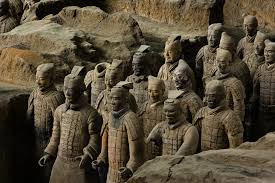
The Terracotta Army: Guardians of an Emperor's Afterlife
The Terracotta Army, a sight that inspires awe and wonder, stands as a testament to the grandeur and ambition of ancient China. This vast collection of life-sized terracotta sculptures has captivated the world since their discovery in 1974. But what led to their creation, and what secrets do they hold about the past?
A Unique Form of Funerary Art
The Terracotta Army belongs to a category of ancient Chinese art known as funerary sculpture. These artistic creations were not meant for public display but were entombed with the deceased, intended to serve and protect them in the afterlife. The practice of crafting elaborate burial objects stemmed from the belief that the deceased continued to exist in another realm and required provisions for their journey.
From Human Sacrifice to Clay Soldiers
The origins of the Terracotta Army can be traced back to a grimmer practice: human sacrifice. In ancient China, particularly during the Shang and Zhou dynasties, it was believed that rulers required companions and servants in the afterlife. This belief led to the cruel practice of burying servants, concubines, and even officials alive with their deceased lord.
As societal values evolved, the brutality of human sacrifice became increasingly unacceptable. A gradual shift occurred from burying live sacrifices to interring effigies made of wood, bronze, and eventually, terracotta. These figures served as symbolic substitutes for living sacrifices, offering a more humane alternative while fulfilling the same spiritual purpose.
A Legacy of Emperor Qin Shi Huang
The Terracotta Army is specifically attributed to the tomb of Qin Shi Huang, the first emperor of a unified China (221-206 BCE). Known for his ambition and desire for immortality, Qin Shi Huang commenced the construction of his mausoleum complex shortly after ascending the throne at the age of thirteen.
The emperor envisioned a subterranean palace that mirrored his earthly domain, complete with an army to protect him from unseen threats. Thus, thousands of life-sized terracotta warriors, each unique in appearance and equipped with realistic weaponry, were meticulously crafted to guard his eternal slumber.
A World Awakened
The accidental discovery of the Terracotta Army in 1974 by farmers digging a well near Xi'an, China, sent shockwaves throughout the world. The sheer scale, detail, and artistry of the figures left historians and archaeologists astounded. The find was hailed as one of the most significant archaeological discoveries of the 20th century, providing invaluable insights into ancient Chinese military practices, craftsmanship, and beliefs surrounding death and the afterlife.
FAQs
Q: How many terracotta warriors are there in total?
A: It is estimated that over 8,000 life-size terracotta figures, including warriors, chariots, and horses, were buried within the mausoleum complex.
Q: Why was each warrior made to look different?
A: The individualization of each figure suggests an attempt to create a realistic army, reflecting the diverse ethnicities and ranks within Qin Shi Huang's military forces.
Q: Has the tomb of Qin Shi Huang been excavated?
A: While the surrounding pits containing the Terracotta Army have been extensively excavated, the central tomb of Qin Shi Huang remains unopened. Concerns about potential damage to the emperor's burial chamber and its contents due to exposure to the open air have prompted archaeologists to proceed with caution.
note: This return of all, without the author's permission, may not be reproduced